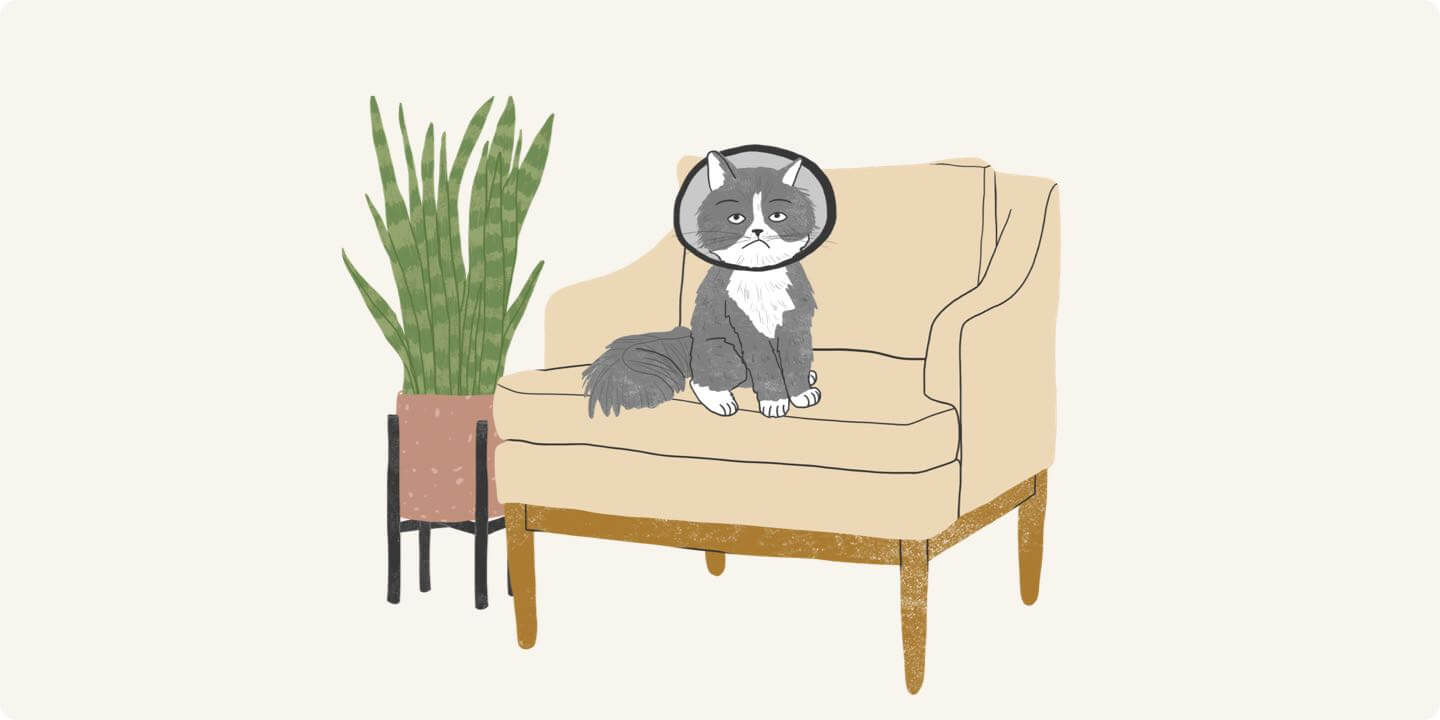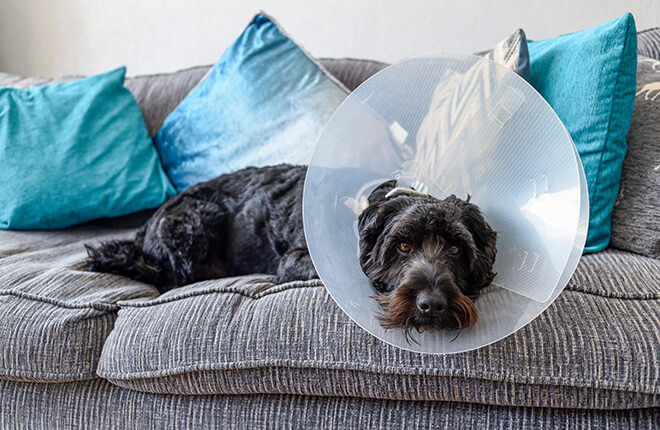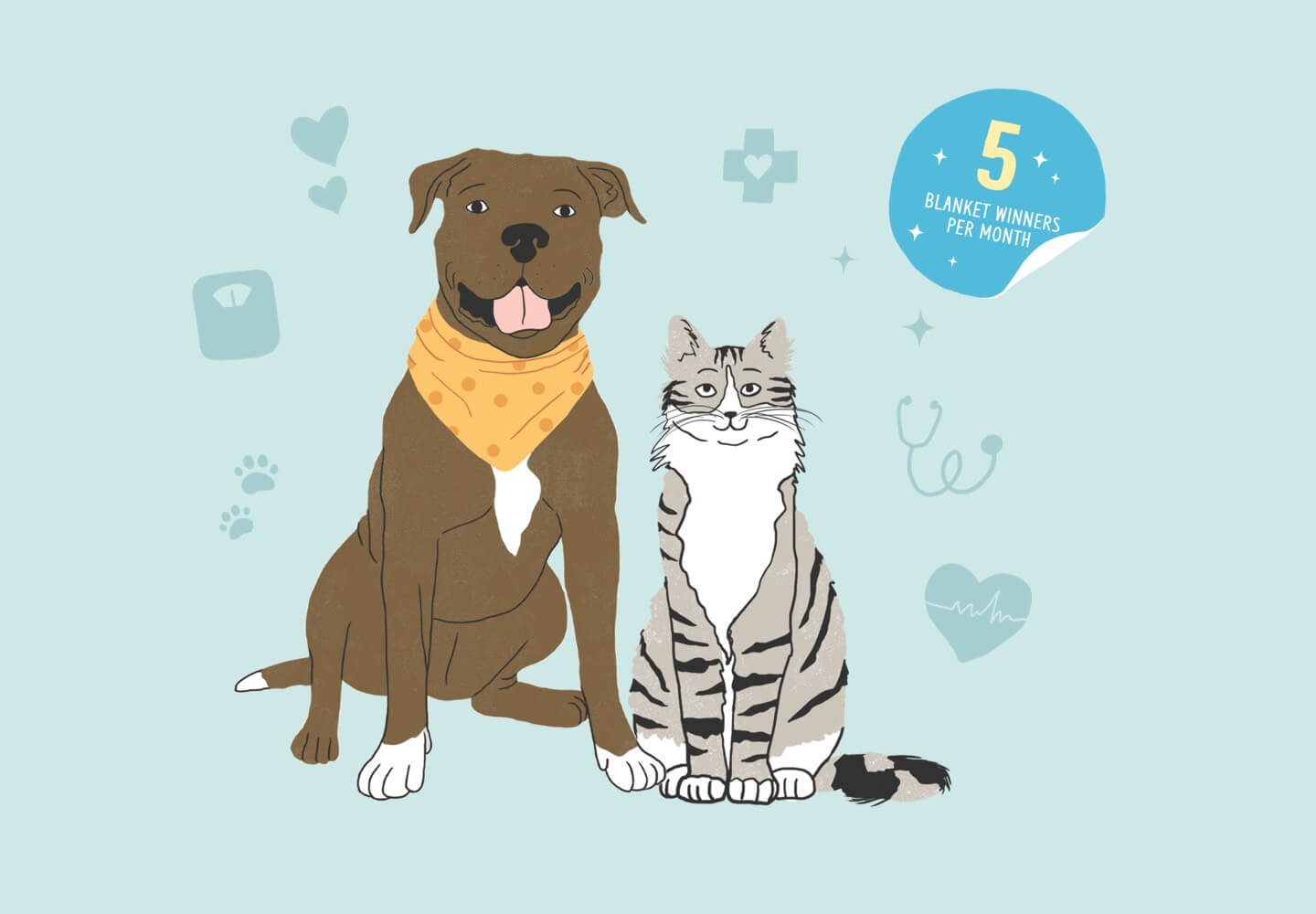Spaying and neutering are common surgical procedures that prevent pregnancies in cats and dogs. Spaying is the surgical removal of the ovaries (usually along with the uterus) of female cats and dogs, while neutering is the surgical removal of the testicles of male cats and dogs. These procedures can also help reduce a pet's risk for some medical conditions, behavioral problems, and even certain emergencies.
Post-op care at home following your cat or dog's spay or neuter is critical to promote recovery and to help prevent complications like pain, infection, bleeding, or other issues that can land them back at the vet for emergency evaluation (or even additional surgery). Proper aftercare helps to ensure the smoothest recovery for your pet following their spay or neuter surgery.

What to Expect After Your Cat or Dog is Spayed or Neutered
When you pick your pet up after their spay or neuter surgery, they could still be a little "out of it." So don't take it personally if they don't greet you with the excitement they usually do. Here are some common things to expect after a spay or neuter:
Grogginess
It's common for pets to be a little tired the evening after their spay or neuter surgery. But if your pet is super sleepy, not responsive to your touch or voice, or otherwise acting in a concerning manner, it's time to call your veterinarian (or an animal ER if your veterinarian's office is closed for the night).
Medications
Though often considered routine procedures, spays and neuters are significant surgeries, and your pet may be prescribed medications to encourage healing and recovery. Your pet may be prescribed veterinary-specific pain medication to manage pain or discomfort after medications administered around surgery wear off. Whatever you do, don't use human pain medications on your pet (even aspirin), as they can cause some severe problems in cats and dogs. Be sure to talk with your veterinary team to ensure that the safest, most effective pain medications are administered to your pet.
Monitor Eating and Drinking
Since your pet had anesthesia, their water and food should be limited immediately upon returning home and in the evening following their procedure. After a few hours, you can usually start by offering them a little bit of water, followed by a small amount of their regular food an hour or so later. This ensures that your pet is able to drink and eat normally following anesthesia and surgery and that they're not likely to vomit and develop aspiration pneumonia or another problem. If they are able to keep these small amounts of water and food down, then you should be able to return to normal water access and feeding the following morning. If not, call your veterinarian.
Spay and Neuter Aftercare for Cats and Dogs
Spay and neuter aftercare for dogs and cats are very similar. Below are some general aftercare tips for both pets:
Exercise Restriction
Strict activity restriction is necessary following spay and neuter surgeries. Activities like running, jumping, and playing can result in stitches failing, bleeding, pain, and other post-surgical problems. Restrict your pet’s post-spay/neuter activity for 10–14 days, according to your veterinarian’s instructions.
Prevent Licking and Chewing
Elizabethan collars ("cones" or E-collars) are important to prevent your pet from licking, chewing, or scratching their surgical area. If your veterinarian recommends a cone following surgery, be sure to use it as advised to avoid potentially serious problems.
Surgical Site Care
Monitor your pet's spay/neuter incision area daily for signs of swelling, discharge, bleeding, or any other problems. If you're noticing any concerning symptoms, be sure to contact your veterinarian. Most spay/neuter skin incisions are fully healed within about 10–14 days, which coincides with the time that stitches or staples, if any, will need to be removed.
Bathing and Swimming
Don't bathe your pet or let them swim until their stitches or staples have been removed and your veterinarian has cleared you to do so. If no visible skin sutures/staples were placed, wait at least 10–14 days until the skin incision is fully healed before bathing or swimming.
Cat Spay and Neuter Aftercare
Cat spay recovery and neuter recovery are very similar. Your cat may benefit from these tips to promote healing:
Indoors Is Best
The risks of surgical site infection or breakdown are considerably higher if a cat is allowed to roam outdoors before their incision site is fully healed.
Kitty Confinement
Often, the best way to restrict activity for a cat following surgery is to either confine them to a large dog kennel or a small, enclosed room (like a bathroom or laundry room). Don't forget to give them a clean litter box in their confinement space and minimize their jumping opportunities.
Litter Changes
There may be some benefit to changing your cat's litter to a non-clumping, low-dust litter during their post-spay/neuter recovery period. This type of litter may be less likely to contaminate and cause other problems at your cat's surgical incision site. Check with your veterinarian to see if they recommend a temporary litter change for your cat. Some cats may also prefer or need a lower-sided litterbox during their post-surgical recovery, so they don't have to step over or climb into a higher-sided or even covered litterbox.
Dog Spay and Neuter Aftercare
Dog spay recovery and neuter recovery are very similar. Your dog may benefit from these tips to promote recovery:
Canine Confinement
In most cases, the best way to limit your dog's activity after a spay or neuter is a crate, exercise pen, or a small room blocked off by a baby gate.
Keep Them Calm
Some dogs may need and benefit from mildly sedating medications and/or supplements prescribed by a veterinarian. If your dog is having trouble settling during their recovery, talk to your veterinarian, as they'll be able to suggest something that may help.
Leash-Up
Dogs shouldn't be allowed off-leash walks or playtime until their incision is fully healed and cleared by your veterinarian (typically 10–14 days).
Avoid the Dog Park
Dog parks are a big no-no for dogs following their spay or neuter procedure. Your dog shouldn't be brought to a doggy daycare or dog park until after their stitches have been removed, their surgical incision has fully healed, and they've been cleared by your veterinarian.
Some Spotting May Be Normal
It's not uncommon for a dog to have a little bit of bloody discharge from their vulva, or in their pee, for a day or two following their spay procedure. Anything lasting more than a day or two, though, or any copious bloody discharge, should be evaluated by your veterinarian.
Even with these general guidelines, always remember that your veterinarian is your best resource for specific questions and advice regarding your pet's care. If you notice any behavior that is not right for your pet, or if there is bleeding from the incision site, contact your vet right away.
ZPC-00814R2



